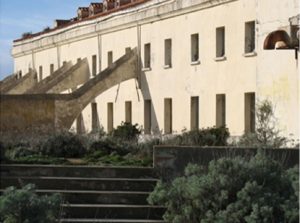محطات المياه
The peninsula where the old city is situated is not water-fed by any river or spring, but instead its needs are covered by the existing underground aquifers, as well as the private and public cisterns that used to store the rain water.
The cave and well of Saint Barthelemy
In the cliff facing Sardinia, there is a cave at an altitude a little higher than the water level. In this cave there is a rich underground source that used to be fresh of good quality in earlier times but today is a bit brackish. The very first inhabitants of the area probably collected water from this cave that extends deep in the cliff.
Later, this route was improved and steps were hewn to ease access. According to the legend these steps were dug one night in 1420 AD by the soldiers of Aragon in order to invade the city, giving it the name “escalier du roi d’ Aragon” (king Aragon steps). Actually, the limestone cliff is too hard to have been dug in one night. The stairs probably existed at that time and were used for supplying water the citadel through the cave and to facilitate the evacuation in case of invasion.
In recent times (late 19th century) this ground water was again used for the needs of the Army. In order to ensure water supply for the barracks, a well named St. Barthelemy (“le puits St. Barthélemy”) after the homonymous church lying on top, was dug by the Military Engineering in order to access the aquifer in a way easier than through the King Aragon stairway.
The well was dug into the limestone cliff with a depth of 60 meters and a diameter of 7 meters. Spiral stairway winds around the well to reach its bottom, after 330 steps. The well reaches the sea level in a cave that opens onto a small bank.
The drilling of the well -which was actually based on a plan of 1668- began in 1857 and lasted six and a half months. The surrounding stairway was completed a few years later in 1860.
At the beginning water was pulled on surface using a closed chain with buckets powered by a blindfolded revolving mule. In later periods a gasoline engine was used which was followed by a submersible pump electrically operated. The pumped water was stocked in a cistern.
Over the centuries, after the construction of the city, the water in the cave (and later the well) has gradually become more brackish due to a decrease in the quantity of fresh water reaching and replenishing the cave. The reasons for this are many: the city cisterns that retained water; the loss of stormwater into the sea through the streets and sewers; the erratic and low rainfall during certain periods.
The cisterns
In order to meet the water needs, cisterns were built mostly by the Genoans. There are three types of cisterns found in the city: private, public and military; and all of them are filled through collecting the rainwater.
a) Private cisterns
More than twenty private cisterns have been counted in the old part of the city. The rain is mainly caught from roofs and led through terracotta pipes in the walls to a cistern on the first floor.
b) Public cisterns
The most impressive public cistern in Bonifacio is found underneath St. Marie Majeure church, the main church of the city dating from the 12th century, modified on numerous occasions and restored in the 18th century.
At the entrance to the church there is the loggia, a small square covered by columned arcades, and beneath it lays the cistern. The cistern used to be managed by the clergymen and contained up to 510 m3 according to a document of the 19th century.
The cistern was fed by the rain: The archways and flying buttresses, which connect and support the houses, were equipped with slate gutters. These archways acted as aqueducts and allowed to collect rainwater falling on the roofs.
This cistern was built around 1318, to ensure water in case of siege or draught. So, it was forbidden to pull out water from it during the dry period between June and October. After October, when rains were abundant, the citizens were allowed to take water. In Bonifacio it is common to have public cisterns below religious monuments. Other monuments equipped with cisterns are e.g. the St Francois’s monastery, the Sainte Croix’ chapel, and the civil hospice.
c) Military cisterns
Bonifacio has always been a military city, with a large presence of soldiers. Consequently, in order to cover the military’s needs, several cisterns were constructed in the city. The main cistern situated under the barracks could contain 500 m3. The collection system is very innovative. Indeed, rain water falling on roofs is collected and conducted in the cistern by the buttresses acting as aqueducts. But rain water is also collected thanks to covered by stone and brick. The cistern was coated in black in order to guarantee maximum waterproof.

Hydria Virtual Museum
At least 10 military cisterns were reported in the city, totalling a capacity of 1,422 m3 according to a document of the 19th century.







